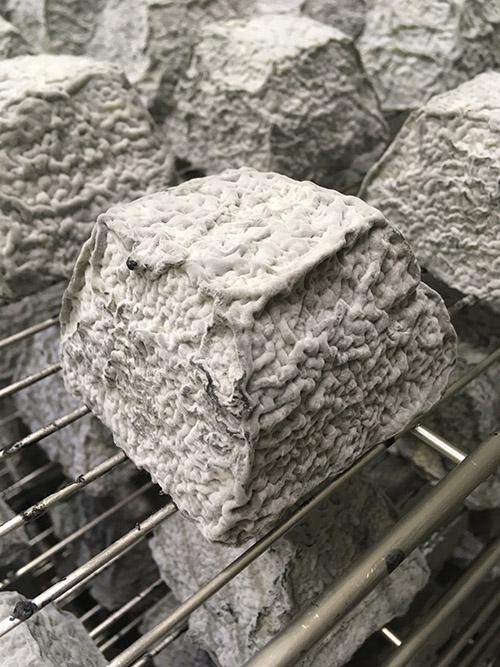Affinage, from the French verb “affiner,” means “to refine,” and is arguably the most important part of the cheesemaking process.
As all the world’s cheeses are made from the same basic ingredients — milk, salt, rennet and cultures — it is the aging process, at the hands of an affineur, that encourages baby cheese wheels to become what they are intended to be. Cheese is a product of both nurture — its milk, terroir and recipe — and nature, or how it's treated during both the making and aging processes. Affineurs, or affinage facilities, may be separate from the dairies or creameries that produced the milk or processed the curds. While some small operations may be an all-in-one facility, many cheeses are aged in separate facilities that specialize in affinage only.
Related reading: 5 Major Cheese Styles Every Chef Should Know
Affinage isn’t as simple as just putting wheels of cheese in caves, however, and waiting to see what happens. To begin with, cheese caves probably aren’t what you think of when you think of a “cave.” Rather, affinage involves various conditions and techniques, as well as timing, that allow different types of cheeses to ripen and evolve according to their particular needs. Here’s a basic primer on the different elements that comprise the concept and art of affinage.

What Are Cheese Caves?
Historically speaking, many cheeses probably began in actual caves, or something like them. Whether natural or man-made, underground caves or cellars provided an element of climate control, mainly in terms of temperature, to allow cheeses to develop without the variances that seasons provide. (Most regions on earth where animals can graze and produce milk have seasonal variations.) Now, few cheeses actually interact with natural caves. Valdeon, a Spanish blue cheese, is an exception, where some makers of Valdeon actually use a natural cave for affinage.
From internationally renowned, historical stalwart cheeses such as Parmigiano-Reggiano, to small-batch, contemporary, American-made cheeses, most cheese caves now resemble simple warehouses or storage rooms, typically windowless, where temperature and humidity can be controlled to achieve very specific conditions.
The Importance of Temperature and Humidity Control in Aging Cheese
Cultures are the specific microbes used to inoculate the milk at the beginning of the cheesemaking process that govern what type of cheese you’re trying to make. Cheeses don’t develop randomly. These microbial cultures serve as the genetic code for the cheese in progress.
Many different kinds of cultures are used in cheesemaking, and different cultures have different requirements where temperature and humidity are concerned. Brainy, wrinkly rind cheeses such as La Tur are a result of a bacterium called geotrichum candidum. The orange rind that signals the telltale waft of washed rind cheeses such as Epoisses is due to a microbe called brevibacterium linens. The blue in blue cheese comes from a strain known as penicillium roqueforti. The goal of affinage is to match the cheese with its correct environment to encourage the development of these and other cultures while discouraging uninvited or undesirable microbes.

Related reading: Understanding Cheese Rinds
Depending on the size of the operation, different cheesemaking facilities may therefore have numerous caves that express different conditions. Murray’s Cheese, for example, which doesn’t actually make cheese but acts as an affinage facility, has five different caves with varying conditions: a washed rind cave, a natural rind cave, a bloomy rind cave, an Alpine cave and a drying room, or haloir. The temperature in these rooms ranges between 48 degrees to 57 degrees Fahrenheit, with a humidity level between 88 to 98 percent. (Note that even the drying room maintains a humidity percentage in the mid-50s.)
Cheeses under affinage may also be moved between facilities during their aging process to encourage different microbes at different stages of a given cheese’s development.
Affinage Techniques
There are few cheeses that go into an aging cave and just stay put until it’s time to come out. Even long-aging cheeses such as Parmigiano-Reggiano, and certain varieties of cheddar and gouda, must be flipped regularly to ensure even ripening. The type of surface on which they sit also plays a factor in how the cheese develops.
Beyond these basic techniques, there are a number of different applications that an affineur may use to ensure the proper development of cheese. Affinage isn’t a passive technique, as many cheeses in various stages of their aging process may need certain treatments, including salting, ashing and brushing. Occasionally cheeses are vacuumed to reduce the presence of cheese mites. Washed rind cheeses need washing — typically a smearing of brine or other solution to get their signature rinds developing. Blue cheeses require piercing, which opens up the oxygen pathways for its blue veining to grow. Cheeses such as manchego may be rubbed with olive oil to create a lack of oxygen on the surface, such that its rind becomes simply a sturdy edge of hardened, preserved cheese material.
Over time, cheese caves can also develop their own unique terroir, due to airborne molecules that reflect the various flora of all of the microbes that have thrived in that facility, and can eventually make their way to any kind of cheese. Understanding the atmosphere of the aging facility, and making adjustments as needed is yet another role of the affineur.
Want to Become an Affineur?
While there are few courses available in the United States for budding affineurs, apprenticeships at various creameries or affinage facilities are often available for those interested.






